Photons & Fusion
March 2011
Photons & Fusion is a monthly review of science and technology at the National Ignition Facility & Photon Science Directorate. For more information , submit a question.
NIF Achieves Record Ramp-Compression Pressure
In the first university-based planetary science experiment at the National Ignition Facility (NIF), researchers have gradually compressed a diamond sample to a record pressure of about 27 megabars (27 million times Earth's atmospheric pressure). By replicating the conditions believed to exist in the cores of several recently discovered "super-Earths"—extra-solar planets three to 20 times more massive than Earth—the experiment could provide clues to the formation and structure of these and other giant planets as well as the exotic behavior of materials at ultrahigh densities.
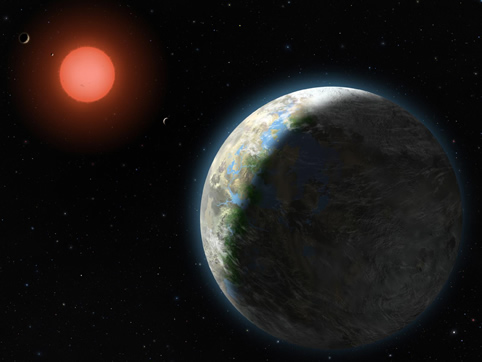 Artist's conception of the inner four planets of the Gliese 581 system and their host star, a red dwarf star 20 light years from Earth. The large planet in the foreground is the newly discovered GJ 581g, which has a 37-day orbit in the middle of the star's habitable zone and is only three to four times the mass of Earth, with a diameter 1.2 to 1.4 times that of Earth. Image Credit: Lynette Cook/NASA
Artist's conception of the inner four planets of the Gliese 581 system and their host star, a red dwarf star 20 light years from Earth. The large planet in the foreground is the newly discovered GJ 581g, which has a 37-day orbit in the middle of the star's habitable zone and is only three to four times the mass of Earth, with a diameter 1.2 to 1.4 times that of Earth. Image Credit: Lynette Cook/NASA
The team of scientists from UC Berkeley, Princeton University and Lawrence Livermore National Laboratory (LLNL) used a carefully shaped 20-nanosecond, 480-kilojoule NIF laser pulse to quasi-isentropically compress, or "ramp-compress," multiple thicknesses of diamond to approximately three times the pressure previously achieved in similar experiments by the same team at the University of Rochester's OMEGA laser (see January/February 2009 Photons & Fusion Newsletter). Use of the time-dependent ramp-wave compression technique is key to keeping the material relatively cool and solid to higher pressures than could be achieved with standard near-instantaneous shock-physics experiments (see Materials at Extreme Conditions).
"It is the reduced level of heating made possible by ramp compression that makes these experiments relevant to the study of planetary interiors," said the experiment's principal investigator, Ray Smith of LLNL's Physics Division.
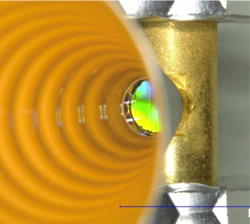 The diamond target is at the end of the VISAR diagnostic cone attached to the gold hohlraum.
The diamond target is at the end of the VISAR diagnostic cone attached to the gold hohlraum.
The standard technique for studying material conditions relevant to planetary interiors is through quasi-static compression in a diamond anvil cell. Those platforms, however, are limited to peak pressures of about three megabars (Mbar), while planetary core pressures range from about 3.5 Mbar (Earth) to about eight Mbar (Neptune), 30 Mbar (extra-solar super-Earths), and 100 Mbar (Jupiter).
"The only way to recreate the interior conditions of large planets is through ramp compression," Smith said, "and currently, as we've just demonstrated, NIF is the highest pressure platform by some way. In fact we believe we can build on these initial experiments and go to even higher pressures."
Up to 30 percent of main-sequence stars are estimated to have planetary companions, and more than 500 exoplanets have been discovered to date. Determining the interior structure and composition of exoplanets is challenging but central to understanding the diversity and evolution of planetary systems. Planetary surface conditions are closely coupled to interior processes, and both have an important influence on the habitability of planetary environments.
A major factor in unraveling the interior structure of planets is establishing the properties of planetary materials under extreme pressure–temperature conditions. Accurate determination of the materials' equation of state (EOS) is a fundamental requirement. Equations of state express the thermodynamic relationship between pressure, temperature, and volume and are used to generate computational models of material behavior, such as the temperatures and pressures at which diamond melts to a dense, metallic fluid (see "Melting temperature of diamond at ultrahigh pressure," Nature Physics 6, 40–43 (2010); doi:10.1038/nphys1438).
Data gathered during the March 8 NIF experiment by the VISAR (Velocity Interferometer System for Any Reflector) diagnostic, a time-resolved Doppler velocity camera, will help the researchers determine the EOS of carbon, including its many potential structures, at extreme pressures.
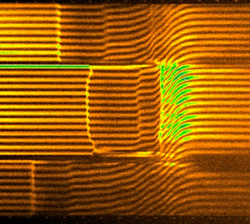 Time-resolved VISAR image of a shock wave from the diamond EOS experiment.
Time-resolved VISAR image of a shock wave from the diamond EOS experiment.
"Diamond is especially interesting from an astrophysical standpoint because carbon is the fourth most abundant element in the universe and is of key importance in planetary science," Smith said. "Ice giant planets such as Neptune and Uranus contain large quantities of methane that decompose at high pressure and temperature conditions, possibly forming diamond-rich layers in their interiors. A number of extra-solar Neptunes and super-Neptunes have already been discovered, and this class of planet is expected to be quite abundant. In addition, for certain protoplanetary disks with high carbon content, the chemistry of planetary formation may lead to the formation of carbon-rich planets dominated by carbides and diamond."
Smith said shock experiments have made considerable progress in furthering understanding of the phase diagram of diamond in the vicinity of the melting boundary, and the pioneering ramp-loading work at the OMEGA laser has investigated the EOS and strength of diamond at pressures up to eight Mbar.
"The behavior of diamond in the solid state at ten to 100 megabars, however, is wholly unexplored at present," he said. "This represents an exciting opportunity for NIF experiments. The melting curve and liquid structure of carbon also hold much interest. Theoretical calculations indicate that the phase diagram of carbon at ultrahigh pressure is complex, with possible transitions from diamond to additional solid phases such as the metastable BC-8 and simple cubic phases.
"Diamond's overall technical and scientific importance and its potential use in laser compression experiments as an ablator or target make this material one of the most important for immediate study," Smith said.
Joining Smith in the experiment were Raymond Jeanloz of U.C. Berkeley and Tom Duffy and Jue Wang of Princeton, along with LLNL researchers Jon Eggert, Dave Braun, Peter Celliers, Reed Patterson, Matt Cowan, Ted Perry, and Rip Collins.
Aligning the NIF Optical Systems
A detailed description of the installation and precision alignment of NIF's optical systems was published in the March 10 issue of Applied Optics (Appl. Opt. 50, 1136–1157 (2011); doi:10.1364/AO.50.001136). In a paper titled, "National Ignition Facility System Alignment," lead author Scott Burkhart and colleagues described the major alignment challenges faced by the NIF Project and how those challenges were met and addressed by the NIF design and commissioning teams. NIF's ability to focus 192 laser beams on a target within a tolerance of 50 micrometers is the culmination of more than a decade of design and commissioning engineering, the authors said (see An Engineering Marvel).
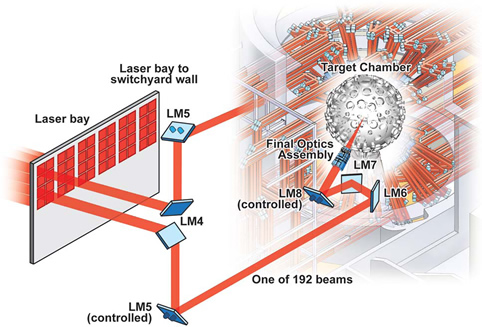 NIF laser beams are transported to the final optics by mirrors LM4-LM8. Mirrors LM5 and LM8 comprise the remotely actuated gimbal pair for alignment to the center of the NIF target chamber.
NIF laser beams are transported to the final optics by mirrors LM4-LM8. Mirrors LM5 and LM8 comprise the remotely actuated gimbal pair for alignment to the center of the NIF target chamber.
"Designing the facility to minimize drift and vibration, placing the optical components in their design locations, commissioning beam alignment, and performing precise system alignment are the key alignment accomplishments," they said. "The design and positioning phases placed more than 3,000 large (2.5 x 2 x 1 m) line-replaceable optics assemblies to within ±1 mm of design requirement. The commissioning and alignment phases validated clear apertures (no clipping) for all beam lines and demonstrated automated laser alignment within 10 min. and alignment to target chamber center within 44 min. Pointing validation system shots to flat gold-plated X-ray emitting targets showed NIF met its design requirement of ±50 µm rms beam pointing to target chamber."
The paper was co-authored by LLNL colleagues Erlan Bliss, Pascale Di Nicola, Dan Kalantar, Roger Lowe-Webb, Tom McCarville, D. Nelson, Thad Salmon, Tania Schindler, John Villanueva, and Karl Wilhelmsen.
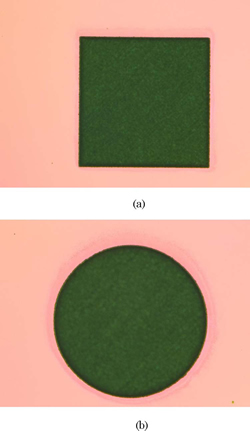 Optical microscope images of femtosecond laser-machined mitigation features. Both mitigation pits are about 1 mm across and 15 microns deep.
Optical microscope images of femtosecond laser-machined mitigation features. Both mitigation pits are about 1 mm across and 15 microns deep.
Fabrication of Mitigation Pits for
Improving Laser Damage Resistance
Meter-scale multilayer high reflector coatings are fluence-limited by a class of extremely low frequency defects and flaws that initiate laser damage and grow with repeated 1053-nm (infrared), 3-ns laser irradiation. One approach for increasing the laser resistance of high reflectors is to initiate the low-fluence defects, identify the unstable damage sites, and then mitigate them—replacing damage sites with a micromachined feature that is stable at or above the operating fluence of the laser system.
In a paper published March 20 in a feature issue of Applied Optics on optical interference coatings (Appl. Opt. 50, C457–C462 (2011); doi:10.1364/AO.50.00C457), LLNL's Justin Wolfe, Roger Qiu, and Christopher Stolz reported that high-damage-threshold mitigation pits have been successfully created on multilayer dielectric mirror coatings using femtosecond laser machining. A companion paper by Roger Qiu and colleagues (Appl. Opt. 50, C373–C381 (2011); doi:10.1364/AO.50.00C373) discussed the electric field modeling of the pits to optimize the proper geometrical shapes.
The authors said these mitigation features can double the fluence-handling capability of large-aperture optical multilayer mirror coatings; the mitigation pits have repeatedly survived laser fluences in excess of 40 J/cm2. "This technology may one day enable large-aperture mirrors, which are currently fluence-limited by extremely rare defects, to perform at laser fluences higher than previously possible," the authors said. "Continued work to further understand the causes and impacts of various defects will guide further process and system optimizations."
Improving Surface Figure and Laser Damage Resistance of Silica Surfaces
Large aperture (40 cm) fused silica optics used in high-peak-power laser systems such as NIF require surfaces with high laser damage thresholds and controlled surface figures. In a March 22 invited presentation at the 5th International Conference on the Flow and Fracture of Advanced Glasses in St. Malo, France, NIF and Photon Science researcher Tayyab Suratwala and colleagues described two recent efforts to achieve these requirements:
- Understanding spatial and temporal material removal during full-aperture deterministic polishing (hence faster and lower cost) of the desired surface figure; and
- Developing chemical etching processes for removing impurities and micro-fractures to improve the optic's laser damage resistance.
In the first effort, kinematics and non-uniformities in the pressure distribution have been quantitatively evaluated and combined into a spatial and temporal material removal model called "SurF" to predict surface figures during polishing.
In the second effort, called the Advanced Mitigation Process (AMP), an optimized aqueous hydrofluoric acid-based etching process is used to largely remove surface micro-fractures (typically scratches) and chemical impurities (typically cerium oxide) found on polished silica surfaces, increasing the surface damage threshold. AMP is now being used to treat fused silica optics for NIF.
Joining Suratwala in preparing the presentation were LLNL researchers Michael Feit, Paul Steele, Phil Miller, Jeffrey Bude, Nan Shen, Ted Laurence, and Lana Wong.




